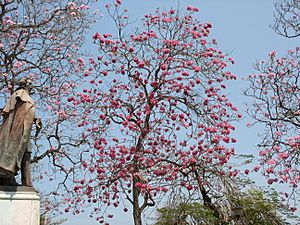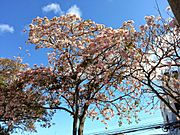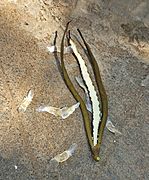Pink poui facts for kids
Quick facts for kids Pink poui |
|
|---|---|
 |
|
| Scientific classification | |
| Genus: |
Tabebuia
|
| Species: |
rosea
|
The Tabebuia rosea, also known as the pink poui or rosy trumpet tree, is a beautiful tree from Central and South America. It can grow very tall, up to 30 meters (about 98 feet), and its trunk can be as wide as 100 centimeters (about 3.3 feet). In Costa Rica, people often call it "roble de sabana," which means "savannah oak." This is probably because its wood looks a bit like oak, and it's often found in areas where many other trees have been cut down. It's also the national tree of El Salvador, where it's called "Maquilíshuat."
Contents
Other Names for the Rosy Trumpet Tree
This tree has different names in various parts of the world:
- In Malaysia, it's known as "tekoma."
- In Sri Lanka, people call it "රොබරෝසියා (Robarōsiyā)."
- In Thailand, its name is "ชมพูพันธุ์ทิพย์."
Where the Rosy Trumpet Tree Grows
You can find the rosy trumpet tree growing naturally from southern México all the way down to Venezuela and Ecuador. It likes warm places and can grow from sea level up to 1,200 meters (about 3,900 feet) high. It prefers average temperatures between 20°C and 30°C (68°F to 86°F) and needs more than 500 mm (about 20 inches) of rain each year. It can also grow in many different types of soil.
This tree is very popular in cities across Central and South America. People often plant it in parks and gardens because it provides great shade during the rainy season. In the dry season, when most of its leaves fall off, it bursts into a stunning display of pink and purple flowers!
What the Rosy Trumpet Tree Looks Like
The rosy trumpet tree usually has a short trunk with branches that spread out in an uneven way. Its bark can be gray or brown and might have vertical cracks.
Leaves and Flowers
Its leaves are special because they are compound and deciduous. This means they are made up of several smaller leaflets, and the tree loses them every year, usually before it flowers. Each leaf has five leaflets, with the one in the middle being the largest.
The tree mostly blooms in January and February, which is usually during the dry season. However, you might also see flowers in August, September, April, and May. The flowers are large and come in beautiful shades of pink to purple. They appear when the tree has few or no leaves, making the pink blooms stand out even more!
Pollination and Seeds
Insects likely help to pollinate the flowers, meaning they help the tree make seeds. Many birds, like tanagers, hummingbirds, and orioles, also visit the flowers.
After flowering, long, thin fruit capsules grow, which can be up to 35 centimeters (about 14 inches) long. These appear from February to April. When the fruit dries, it opens up and releases many light, winged seeds. These seeds are carried by the wind. There are about 45,000 seeds in one kilogram (about 2.2 pounds), and they sprout very easily, almost 100% of the time! This tree also grows quite fast.
Traditional Uses of the Rosy Trumpet Tree
For a long time, people have used parts of the rosy trumpet tree in traditional medicine.
- Preparations made from the bark have been used to help with stomach problems and to reduce fevers.
- A special tea made from the bark has been suggested for people feeling weak or having trouble with digestion.
- Teas made from the flowers, leaves, and roots have been used to lower fevers, ease pain, and help with sore throats.
Scientists have studied some natural compounds found in the tree, like one called lapachol. This compound is related to vitamin K. While it was once looked at for its potential health benefits, it is not widely used today because it can have strong side effects.
See also
 In Spanish: Tajibo para niños
In Spanish: Tajibo para niños




